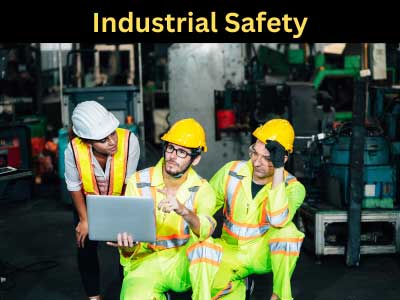Key Takeaway
Industrial safety types refer to the various methods and practices used to ensure the safety of workers in industrial environments. The main types include personal protective equipment (PPE), safety protocols, and machinery safeguards. PPE includes items like helmets, gloves, and safety goggles that protect workers from hazards. Safety protocols are rules and procedures designed to prevent accidents, such as regular equipment maintenance and emergency response plans.
Machinery safeguards are devices and measures installed on machines to prevent injuries. These can include guards, sensors, and automatic shut-offs that stop machinery when a risk is detected. Understanding and implementing these industrial safety types is crucial for maintaining a safe and efficient workplace. This reduces the risk of accidents and ensures compliance with safety regulations.
Overview of Key Industrial Safety Precautions
Industrial safety precautions are measures taken to prevent accidents, injuries, and hazards in workplaces. These precautions are necessary for protecting workers and ensuring safe operations. They include maintaining a clean and organized work environment, implementing machine guards, regular maintenance, and providing employees with proper instructions on operating machinery. Additionally, signs and labels should clearly mark hazardous areas, and equipment should be checked regularly for malfunctions.
Precautions are also industry-specific, such as using appropriate Personal Protective Equipment (PPE) for construction or chemical industries. Following these safety measures helps create a safer workplace, reducing the risk of accidents. Employers should consistently reinforce these practices to ensure compliance and safety awareness across all levels of the workforce.

The Role of Personal Protective Equipment (PPE)
Personal Protective Equipment (PPE) plays a critical role in industrial safety. It refers to any equipment worn by employees to minimize exposure to workplace hazards. This includes items like helmets, gloves, safety goggles, face shields, respirators, and protective clothing. The proper use of PPE can prevent serious injuries related to physical, chemical, or biological hazards, especially in high-risk industries like construction, manufacturing, and chemical processing.
Ensuring that workers use the correct PPE for their job is vital. For example, in chemical plants, respirators protect employees from harmful fumes, while in construction, hard hats shield them from falling objects. Proper training on how to use, maintain, and inspect PPE is essential to ensure its effectiveness. Additionally, management should provide regular PPE checks and replace faulty equipment to maintain safety standards.
Safe Equipment Usage and Maintenance
Proper equipment usage and regular maintenance are crucial in preventing workplace accidents. Machines, tools, and other industrial equipment must be used as intended, following the manufacturer’s guidelines and industry regulations. Workers should be trained on the correct handling and operation of machinery to avoid misuse, which can lead to accidents or malfunctions.
Routine maintenance is essential for identifying and fixing potential issues before they escalate into safety risks. This includes inspecting machines for wear and tear, cleaning machinery regularly, and ensuring all safety features, such as emergency shutoff buttons, are operational. Following a structured maintenance schedule helps in minimizing equipment failure and ensures that all machines are functioning safely and efficiently, protecting both workers and the production process.
Emergency Procedures and Risk Mitigation Plans
Every workplace should have clear emergency procedures and risk mitigation plans in place. Emergencies such as fires, chemical spills, equipment malfunctions, or natural disasters require swift, coordinated responses to ensure safety. These procedures should outline how employees should react in different scenarios, including evacuation routes, first aid measures, and emergency contact information.
Risk mitigation plans are developed to prevent or minimize hazards before they occur. They involve identifying potential risks and establishing strategies to reduce their impact, such as installing fire suppression systems, creating chemical containment areas, or providing proper ventilation in confined spaces. Regular emergency drills and employee training on these procedures ensure that everyone knows how to respond during a crisis, reducing panic and improving safety outcomes.
Training Employees to Follow Safety Precautions
Employee training is one of the most effective ways to ensure safety in industrial environments. Training programs should focus on teaching workers about the specific risks in their workplace and the safety measures needed to avoid them. This includes instruction on using PPE, handling hazardous materials, operating machinery, and following emergency procedures.
Ongoing safety training should be part of the company’s culture, with regular refresher courses to keep safety top of mind. In addition, employees should be encouraged to report unsafe conditions and suggest improvements to safety practices. By fostering a culture of safety through continuous education, companies can reduce accidents and ensure compliance with safety regulations, ultimately protecting both workers and business operations.
Conclusion
Industrial safety precautions are essential for creating a secure and efficient working environment. By ensuring the proper use of Personal Protective Equipment (PPE), regularly maintaining equipment, and adhering to safety protocols, companies can prevent accidents and minimize risks. These precautions are not only about compliance with regulations but also about fostering a safety-conscious culture that empowers employees to take an active role in workplace safety.
Moreover, having clear emergency procedures in place, combined with ongoing employee training, ensures that workers are well-prepared to handle any unforeseen incidents. This proactive approach reduces downtime caused by accidents, enhances operational efficiency, and boosts employee morale. Ultimately, prioritizing safety leads to improved productivity and long-term success by safeguarding both the workforce and the business.
